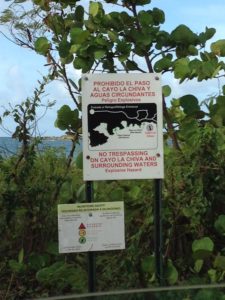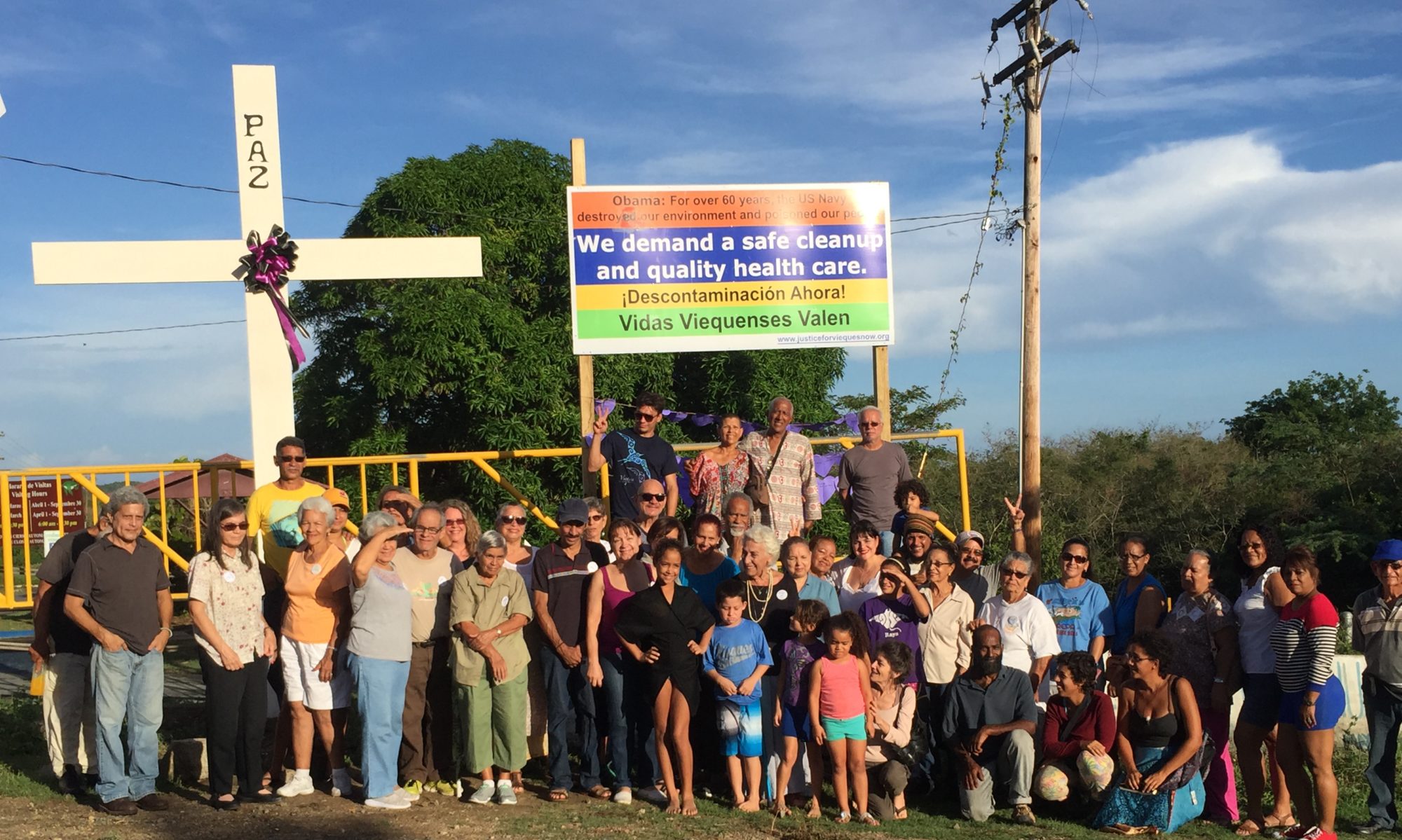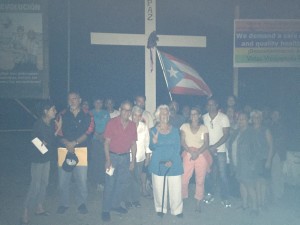Viequenses visit Cayo La Chiva to develop a community-based plan
(translated from Spanish by Kathy Gannett)
FOR IMMEDIATE RELEASE- October 8, 2016- PRESS RELEASE

Contacts: James Larkins, Friends of Cayo La Chiva 787-635-4950
Myrna Pagán, Vidas Viequense Valen 818-963-2344
Vieques – Vieques residents gathered on the La Chiva beach to leave in boats of supporting fishermen to develop for the first time a community plan for The La Chiva Cayo (Key). Cayo la Chiva, just outside La Chiva beach was one of the areas that the Navy of the United States used for maneuvers. Currently signs saying “No Trespassing on Cayo La Chiva and the Surounding Waters – Explosive Hazard” are posted on the La Chiva Beach which is located on the grounds of the Refuge in the east of Vieques, which was transferred to the Fish and Wildlife Service of the United States after the Navy stopped the bombing. Today Saturday, October 8, 2016, a group of 18 residents, consultants and employees of Natural Resources meet to visit and discuss how they want to manage this Cayo. The cayos of Puerto Rico are in the public domain, held by the Department of Natural Resources. Today’s visit marks a precedent for community groups in the management of natural resources in Puerto Rico.
“In the last Public Meeting of Restoration Advisory Board, RAB, for its acronym in English, on August 2, 2016, a plan for Cayo La Chiva was presented but we did not think the plan was in harmony with the vision we have for the Cayo. We are very concerned about any potential unplanned development in Vieques so it is important to plan the use of all of the land that the Navy left contaminated due to military practices, land which they used to hold maneuvers and to test even Agent Orange for more than 60 years. So we declare ourselves against plan proposed by the Navy for Cayo La Chiva and quickly organized ourselves as the collective Friends of Cayo La Chiva.” James Larkins of the Friends of Cayo la Chiva.
“We declare Cayo La Chiva heritage of Vieques and of humanity. We are keeping alive the struggle for the land of Vieques after the departure of the Navy in 2003. We want to show that the Vieques that we dream of is possible. So we are now working on this plan because we know that together we can start building the Vieques that we want. Our group includes archaeologists, farmers, health specialists, agronomists, designers, architects, engineers, and many other experts. We believe that together we can make the restoration plan for Cayo we truly serve us, the Viequenses, and not external interests. For a long time we have been deceived but today we are designing with the community. El Cayo has historical sites, is an amazing space of rock karst and we want to make use of the area,” said Juliana Ramos of the Friends of Cayo La Chiva.
“We are prisoners in our own land, the Navy of the United States moved our families out of these lands and kept us imprisoned for 60 years. Still they limit us to a third of the island, and now for 13 years the majority of Vieques is under the control of the Fish and Wildlife Refuge. For a total 73 years we are prisoners in our own land… almost 100 years. Today we are organized to rescue our lands, it is important that we are, with Natural Resources, the custodians of this Cayo. So today we are planning for all the possible uses. We will be measuring trees, taking inventory of species, noting areas for gazebos, lookouts, kayak routes, among other uses. This plan will be presented to the Navy, but first we will have several presentations in our communities where we will make changes to include the thinking of our people. Then the plan will be delivered to the Navy and the Department of Natural and Environmental Resources,” said Carlos “Chasty” Connelly Pagán, spokesman for the group Friends of Cayo La Chiva.
Our demands:
Vieques Cleanup — Fund a complete, rapid cleanup of the land and surrounding waters, still littered by thousands of bombs, grenades, napalm, Agent Orange, depleted uranium and other explosives left by the Navy. Cease the ongoing open detonation of unexploded ordnance. Guarantee community participation in the cleanup; train Viequenses as managers, administrators, and scientists, and foster Viequense companies to do the work.
Demilitarization and Return of the Land — Close the remaining military installations still occupying 200 acres of Vieques. Return to the people of Vieques all land still under the control of the U.S. Navy and the federal government.
###
(original in Spanish)
Viequenses visitan Cayo La Chiva para desarrollar un plan de base comunitario (Viequenses visit La Chiva to develop land use plan.)
PARA DIVULGACIÓN INMEDIATA
8 de octubre de 2016
COMUNICADO DE PRENSA
Contactos: James Larkins, Amigos del Cayo La Chiva 787-635-4950
Myrna Pagán, Vidas Viequenses Valen 818-963-2344
Vieques- Residentes de Vieques se reunieron en la playa La Chiva para partir en botes de pescadores solidarios a desarrollar por primera vez un plan comunitario para un cayo. El Cayo la Chiva, a las afueras de la playa La Chiva fue uno de los espacios que la Marina de Guerra de los Estados Unidos utilizó para sus maniobras. Actualmente se ven letreros de “cuidado municiones” en la playa La Chiva que se encuentra en los predios transferidos al Refugio de Pesca y Vida Silvestre de los Estados Unidos en el área este luego de la Marina cesar el fuego en Vieques. Hoy sábado, 8 de octubre de 2016 se reúne un grupo de 18 residentes, consultores y empleados de Recursos Naturales para visitar y discutir como quieren se maneje dicho cayo. Los cayos de Puerto Rico son de dominio público, custodiados por el Departamento de Recursos Naturales, la visita del día de hoy marca un precedente para grupos comunitarios en el manejo de los recursos naturales en Puerto Rico.
“En la última reunión el 2 de agosto de 2016 del Public Meeting Restoration Advisory Board, RAB, por sus siglas en inglés, se presentó un plan para el Cayo La Chiva pero no pensamos el plan era cónsono con la visión que tenemos para el Cayo. Estamos muy preocupados por cualquier potencial de desarrollo no planificado en Vieques por eso es importante planificar el uso entre todos de los espacios que la Marina de Guerra nos dejó contaminados por las prácticas militares, terrenos que utilizaron para maniobrar y experimentar hasta con agente naranja por más de 60 años. Así que nos declaramos en contra del plan propuesto por la Marina en torno al Cayo La Chiva y rápido nos organizamos como el colectivo Amigos del Cayo La Chiva.” James Larkins de los Amigos del Cayo la Chiva.
“Declaramos el Cayo La Chiva Patrimonio de Vieques y de la humanidad. Estamos manteniendo viva la lucha por los terrenos de Vieques luego de la salida de la Marina en el 2003. Queremos demostrar que el Vieques que soñamos es posible, por eso estamos hoy trabajando este plan, por que sabemos que entre todos podemos ir construyendo el Vieques que queremos. En el grupo hay arqueólogos, agricultores, especialistas en salud, agrónomos, diseñadores, arquitectos, ingenieros, y muchos otros expertos, entendemos que entre todos podemos hacer el plan de restauración para el Cayo que verdaderamente nos sirva a nosotros los viequenses y no a intereses externos. Por mucho tiempo nos han engañado pero hoy estamos diseñando en comunidad. El Cayo tiene yacimientos históricos, es un espacio increíble de roca de karso y queremos aprovecharlo”, enfatizó Juliana Ramos del grupo de Amigos del Cayo La Chiva.
“Estamos presos en nuestra propia tierra, la Marina de Guerra de los Estados Unidos desplazó nuestras familias de estas tierras y nos mantuvo presos por 60 años. Todavía nos mantienen en un tercio de la isla, pero ahora se trata del Refugio de Pesca y Vida Silvestre que lleva 13 años. Un total de 73 años presos en nuestra propia tierra, casi 100 años. Hoy nos organizamos para rescatar nuestras tierras, es importante que seamos nosotros con Recursos Naturales los custodios de este cayo. Por eso hoy estamos planificando entre todos los usos que le queremos dar, estaremos midiendo árboles, haciendo inventario de especies, observando áreas para gazebos, miradores, rutas para kayak, entre otros usos. Este plan se le presenta a la Marina, pero primero tendremos varias presentaciones en nuestras comunidades donde haremos cambios para incluir el pensar de nuestra gente y luego se le entregará a la Marina y al Departamento de Recursos Naturales y Ambientales”, sostuvo Carlos “Chasty” Connelly Pagán, portavoz del grupo de Amigos del Cayo La Chiva.
Sobre la Limpieza de Vieques
Financiar una completa y rápida limpieza de los terrenos y las aguas circundantes, todavía hay miles de bombas, granadas, napalm, Agente Naranja, uranio reducido y otros explosivos dejados atrás por la Marina. Detener la explosión abierta de bombas sin detonar.
Garantizar la participación de la comunidad en la limpieza; entrenar viequenses como gerentes, administradores y científicos, así como promover oportunidades a las empresas viequenses para hacer ese trabajo.
Sobre la Desmilitarización y Devolución de Todos los Terrenos
Cerrar las instalaciones militares que aún quedan y que ocupan unos 200 acres de Vieques. Devolver al pueblo de Vieques toda la tierra aún bajo el control de la Marina de EE.UU. y el gobierno federal.
###


